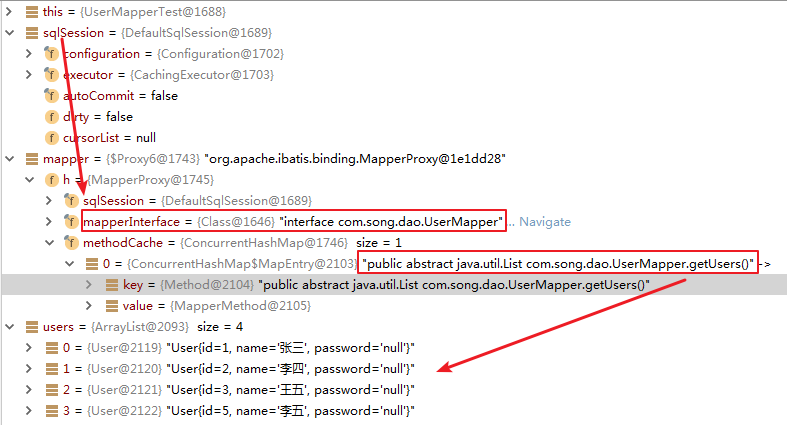八、使用注解开发
8.1 面向接口编程
- 大家之前都学过面向对象编程,也学习过接口,但在真正的开发中,很多时候我们会选择面向接口编程
- 根本原因 : 解耦 , 可拓展 , 提高复用 , 分层开发中 , 上层不用管具体的实现 , 大家都遵守共同的标准 , 使得开发变得容易 , 规范性更好
- 在一个面向对象的系统中,系统的各种功能是由许许多多的不同对象协作完成的。在这种情况下,各个对象内部是如何实现自己的,对系统设计人员来讲就不那么重要了;
- 而各个对象之间的协作关系则成为系统设计的关键。小到不同类之间的通信,大到各模块之间的交互,在系统设计之初都是要着重考虑的,这也是系统设计的主要工作内容。面向接口编程就是指按照这种思想来编程。
关于接口的理解
-
接口从更深层次的理解,应是定义(规范,约束)与实现(名实分离的原则)的分离。
-
接口的本身反映了系统设计人员对系统的抽象理解。
-
接口应有两类:
-
第一类是对一个个体的抽象,它可对应为一个抽象体(abstract class);
-
第二类是对一个个体某一方面的抽象,即形成一个抽象面(interface);
-
-
一个体有可能有多个抽象面。抽象体与抽象面是有区别的。
三个面向区别
- 面向对象是指,我们考虑问题时,以对象为单位,考虑它的属性及方法
- 面向过程是指,我们考虑问题时,以一个具体的流程(事务过程)为单位,考虑它的实现
- 接口设计与非接口设计是针对复用技术而言的,与面向对象(过程)不是一个问题,更多的体现就是对系统整体的架构
8.2 使用注解开发
mybatis最初配置信息是基于 XML,映射语句(SQL)也是定义在 XML 中的。而到 MyBatis 3 提供了新的基于注解的配置。不幸的是,Java 注解的的表达力和灵活性十分有限。最强大的 MyBatis 映射并不能用注解来构建。
注意:使用注解开发,不需要 mapper.xml 映射文件
- 注解在接口上实现
public interface UserMapper {
@Select("select * from user")
List<User> getUsers();
}
- 需要在 MyBatis 核心配置文件中绑定接口(注入)
<!--绑定接口-->
<mappers>
<mapper class="com.song.dao.UserMapper"/>
</mappers>
- 测试及 Debug
@Test
public void getUsers(){
SqlSession sqlSession = MybatisUtils.getSqlSession();
// 底层主要应用反射
UserMapper mapper = sqlSession.getMapper(UserMapper.class);
List<User> users = mapper.getUsers();
for (User u: users){
System.out.println(u);
}
sqlSession.close();
}

本质:反射机制实现
底层:动态代理
8.3 注解 CRUD(@select ()、@update ()、@Insert ()、@delete ())
增删改一定记得对事务的处理,可以在工具类 MybatisUtils.class 创建的时候实现自动提交事务。
实现方式:改造MybatisUtils工具类的 getSession( ) 方法,重载实现。
public class MybatisUtils {
...
public static SqlSession getSqlSession(){
// 打开自动提交
return sqlSessionFactory.openSession(true);
}
}
- 必须先将接口注册绑定(通过class)到 MyBatis 的核心配置文件中(如果有多个接口,每个接口都要绑定)
<!--绑定接口-->
<mappers>
<mapper class="com.song.dao.UserMapper"/>
</mappers>
- 编写接口,增加注解
public interface UserMapper {
@Select("select * from user")
List<User> getUsers();
// 方法存在多个参数,所有参数前面必须加上 @Param("id") 注解,sql语句中#{}内的值要与这个值一致
@Select("select * from user where id = #{id} ")
User getUserById(@Param("id") int id);
@Insert("insert into user(id,name,pwd) values (#{id},#{name},#{password})")
int addUser(User user);
@Update("update user set name = #{name}, pwd = #{password} where id = #{id}")
int updateUser(User user);
@Delete("delete from user where id = #{uid}")
int deleteUser(@Param("uid") int id); // 注意 uid
}
- 测试类测试
【注意】确保实体类和数据库字段对应
关于 @Param 注解:
用于给方法参数起一个名字
- 参数是基本类型或 String 类型,需要加上
- 参数是引用类型 Javabean,不需要加
- 如果只有一个基本类型的话,可以忽略,但是建议加上
- 在 SQL 中引用的就是这里的 @Param(" ") 中设定的属性
- 不使用 @Param 注解时,参数只能有一个,并且是 Javabean。
#{} 和 ${} 区别
-
#{} 的作用主要是替换预编译语句 (PrepareStatement) 中的占位符 ? 【推荐使用】
安全,可以防止 SQL 注入
INSERT INTO user (name) VALUES (#{name}); INSERT INTO user (name) VALUES (?); -
${} 的作用是直接进行字符串替换
INSERT INTO user (name) VALUES ('${name}'); INSERT INTO user (name) VALUES ('kuangshen');
九、Lombok
Project Lombok is a java library that automatically plugs into your editor and build tools, spicing up your java.
Never write another getter or equals method again, with one annotation your class has a fully featured builder, Automate your logging variables, and much more.
使用步骤:
- 在 IDEA 中安装 Lombok
- 在项目中导入 Lombok 的 jar 包
<!-- https://mvnrepository.com/artifact/org.projectlombok/lombok -->
<dependency>
<groupId>org.projectlombok</groupId>
<artifactId>lombok</artifactId>
<version>1.18.10</version>
<scope>provided</scope>
</dependency>
- 在实体类上加注解即可
@Data
@AllArgsConstructor
@NoArgsConstructor
public class User {
private int id;
private String name;
private String password;
}
常见注解:
@Getter and @Setter
@FieldNameConstants
@ToString
@EqualsAndHashCode
@AllArgsConstructor, @RequiredArgsConstructor and @NoArgsConstructor
@Log, @Log4j, @Log4j2, @Slf4j, @XSlf4j, @CommonsLog, @JBossLog, @Flogger, @CustomLog
@Data
@Builder
@SuperBuilder
@Singular
@Delegate
@Value
@Accessors
@Wither
@With
@SneakyThrows
@val
说明:
-
@Data:无参构造、get、set、tostring、hashcode、equals
-
@AllArgsConstructor:有参构造
-
@NoArgsConstructor:无参构造